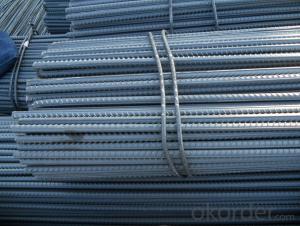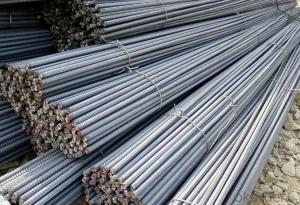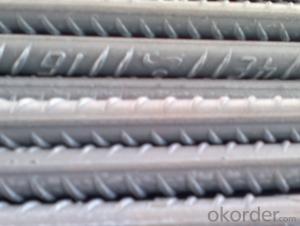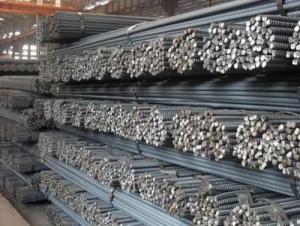Reinforcing Deformed with high quality Steel Bars
- Loading Port:
- Tianjin
- Payment Terms:
- TT or LC
- Min Order Qty:
- 50 m.t
- Supply Capability:
- 20000 m.t/month
OKorder Service Pledge
OKorder Financial Service
You Might Also Like
Product Description:
OKorder is offering Reinforcing Deformed with high quality Steel Bars Building Material China Manufacturer at great prices with worldwide shipping. Our supplier is a world-class manufacturer of steel, with our products utilized the world over. OKorder annually supplies products to European, North American and Asian markets. We provide quotations within 24 hours of receiving an inquiry and guarantee competitive prices.
Product Applications:
Reinforcing Deformed with high quality Steel BarsBuilding Material China Manufacturer are ideal for structural applications and are widely used in the construction of buildings and bridges, and the manufacturing, petrochemical, and transportation industries.
Product Advantages:
OKorder's Reinforcing Deformed with high quality Steel Bars,Building Material China Manufacturer are durable, strong, and resist corrosion.
Main Product Features:
· Mill test certification
· Professional Service
· Competitive pricing
Product Specifications:
HRB400 Deformed Steel Bar Details:
Minimum Order Quantity: | 25MT | Unit: | m.t. | Loading Port: | China Main Port |
Supply Ability: | 800000TONS/YEAR | Payment Terms: | TT or LC |
Product Description:
Specifications of HRB400 Deformed Steel Bar:
Standard | GB | HRB400 | |
Diameter | 6mm,8mm,10mm,12mm,14mm,16mm,18mm,20mm, 22mm,25mm,28mm,32mm,36mm,40mm,50mm | ||
Length | 6M, 9M,12M or as required | ||
Place of origin | Hebei, China mainland | ||
Advantages | exact size, regular package, chemical and mechanical properties are stable. | ||
Type | Hot rolled deformed steel bar | ||
Brand name | DRAGON | ||
Chemical Composition: (Please kindly find our chemistry of our material based on HRB500 as below for your information)
Grade | Technical data of the original chemical composition (%) | ||||||
C | Mn | Si | S | P | V | ||
HRB400 | ≤0.25 | ≤1.60 | ≤0.80 | ≤0.045 | ≤0.045 | 0.04-0.12 | |
Physical capability | |||||||
Yield Strength (N/cm²) | Tensile Strength (N/cm²) | Elongation (%) | |||||
≥400 | ≥570 | ≥14 | |||||
Theoretical weight and section area of each diameter as below for your information:
Diameter(mm) | Section area (mm²) | Mass(kg/m) | Weight of 12m bar(kg) |
6 | 28.27 | 0.222 | 2.664 |
8 | 50.27 | 0.395 | 4.74 |
10 | 78.54 | 0.617 | 7.404 |
12 | 113.1 | 0.888 | 10.656 |
14 | 153.9 | 1.21 | 14.52 |
16 | 201.1 | 1.58 | 18.96 |
18 | 254.5 | 2.00 | 24 |
20 | 314.2 | 2.47 | 29.64 |
22 | 380.1 | 2.98 | 35.76 |
25 | 490.9 | 3.85 | 46.2 |
28 | 615.8 | 4.83 | 57.96 |
32 | 804.2 | 6.31 | 75.72 |
36 | 1018 | 7.99 | 98.88 |
40 | 1257 | 9.87 | 118.44 |
50 | 1964 | 15.42 | 185.04 |
FAQ
Q1: How do we guarantee the quality of our products?
A1: We have established an advanced quality management system which conducts strict quality tests at every step, from raw materials to the final product. At the same time, we provide extensive follow-up service assurances as required.
Q2: How soon can we receive the product after purchase?
A2: Within three days of placing an order, we will begin production. The specific shipping date is dependent upon international and government factors, but is typically 7 to 10 workdays.
Q3: Why buy Materials & Equipment from OKorder.com?
A3: All products offered byOKorder.com are carefully selected from China's most reliable manufacturing enterprises. Through its ISO certifications, OKorder.com adheres to the highest standards and a commitment to supply chain safety and customer satisfaction.
Images:
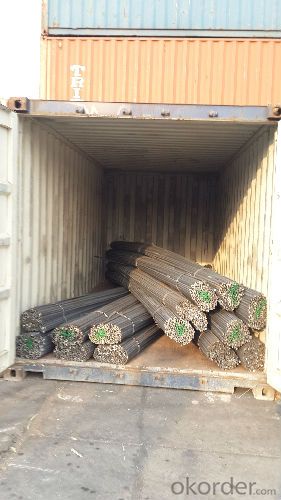
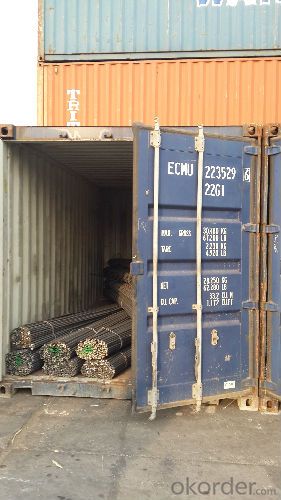
- Q:What are the different types of steel rebars used in tunnel constructions?
- Tunnel constructions rely on the use of different steel rebars to strengthen and fortify the tunnels. These rebars play a vital role in providing stability and reinforcement to the tunnel structures. Below are several types of steel rebars commonly utilized in tunnel constructions: 1. Mild Steel Rebars: Also known as black or carbon steel rebars, mild steel rebars are the most frequently employed in tunnel constructions. They are both cost-effective and possess sufficient strength to meet the structural demands of tunnels. 2. High-Strength Steel Rebars: High-strength steel rebars, sometimes referred to as tension steel, offer enhanced tensile strength, making them ideal for tunnels that require high load-bearing capabilities. These rebars are typically fabricated from alloys such as ASTM A615 Grade 80 or ASTM A706 Grade 80. 3. Stainless Steel Rebars: Stainless steel rebars are resistant to corrosion and provide excellent durability in harsh tunnel environments. They are commonly used in tunnel constructions where corrosion protection is vital, such as in marine or coastal areas. 4. Epoxy-Coated Rebars: Epoxy-coated rebars are regular mild steel rebars that have been coated with epoxy to safeguard against corrosion. They are often employed in tunnel constructions that are exposed to moisture, chemicals, or other corrosive elements. 5. Galvanized Rebars: Galvanized rebars are coated with a layer of zinc to shield them from corrosion. They are commonly used in tunnel constructions that are exposed to moisture or in regions with high humidity levels. 6. Fiberglass Rebars: Fiberglass rebars, also known as GFRP (Glass Fiber Reinforced Polymer) rebars, are lightweight and resistant to corrosion. They are used in tunnel constructions where reducing weight is crucial or in areas with high electromagnetic interference. 7. Carbon Fiber Rebars: Carbon fiber rebars, also called CFRP (Carbon Fiber Reinforced Polymer) rebars, possess high tensile strength and are resistant to corrosion. They are often utilized in tunnel constructions that require high tensile strength and resistance to chemical or environmental degradation. Choosing the appropriate type of steel rebar for tunnel constructions depends on various factors such as load-bearing requirements, exposure to corrosion, environmental conditions, and project budget. It is advisable to consult with structural engineers or construction experts to ensure the optimal selection of steel rebars for tunnel projects.
- Q:How are steel rebars connected or joined together?
- Different methods are used to connect steel rebars depending on the specific application and structural requirements. Steel rebars are typically connected or joined together using the following techniques: 1. Overlapping: An effective method involves overlapping two rebars to create a continuous length of reinforcement. The overlapping length must meet the specified design requirements and is usually secured using steel tie wires or mechanical connectors. 2. Welding: Another option is to join steel rebars through welding. This process involves melting the ends of the rebars and fusing them together using heat. Welding is suitable for connecting rebars in pre-fabricated structures or when high strength and durability are necessary. 3. Mechanical couplers: Pre-fabricated devices known as mechanical couplers provide a threaded connection between two rebars. These couplers are typically screwed onto the ends of the rebars, creating a strong and reliable connection. Mechanical couplers are commonly used in construction projects where fast installation and ease of use are important. 4. Lap splicing: A widely used method in reinforced concrete structures involves connecting two rebars by overlapping them and securing the overlap with steel tie wires or mechanical connectors. This approach provides adequate strength and continuity. 5. Grouted splicing: In grouted splicing, the ends of two rebars are embedded into a sleeve or coupling filled with grout or epoxy resin. This ensures a strong bond between the rebars, enhancing load transfer and corrosion resistance. It is crucial to adhere to applicable building codes and structural design specifications when selecting the connection method for steel rebars. This ensures the overall integrity and safety of the structure.
- Q:What are the different types of steel rebars used in precast concrete constructions?
- There are several types of steel rebars commonly used in precast concrete constructions, including plain round bars, deformed bars, epoxy-coated bars, stainless steel bars, and galvanized bars. Each type offers specific properties and advantages depending on the project requirements and environmental conditions.
- Q:What are the design considerations for using steel rebars in construction?
- Some important design considerations for using steel rebars in construction include the required strength and load-bearing capacity, corrosion resistance, compatibility with other construction materials, durability, and ease of installation. Steel rebars should be chosen based on their appropriate diameter, grade, and spacing to ensure structural integrity and safety. Additionally, proper detailing and placement of rebars are essential to ensure that they are effectively embedded within concrete and can withstand the anticipated stresses and forces during construction and throughout the lifespan of the structure.
- Q:How do steel rebars affect the overall vibration resistance of a structure?
- The overall vibration resistance of a structure can be significantly enhanced by the use of steel rebars. These reinforcement bars, also known as rebars, are typically made of high-strength steel and are commonly utilized in reinforced concrete structures. Rebars play a crucial role in providing tensile strength to the concrete, which is inherently weak in tension. By embedding the rebars within the concrete, they effectively counteract the potential tensile forces resulting from applied loads or vibrations. Steel rebars assist in distributing stress and strain throughout the structure, thereby preventing localized failure points and increasing the overall structural integrity. Furthermore, rebars act as a damping mechanism in the case of vibrations, absorbing and dissipating vibrational energy. This damping effect reduces both the amplitude and frequency of vibrations, thereby enhancing the structure's resistance to damage caused by vibrations. Additionally, the presence of rebars enhances the dynamic properties of the structure, including its natural frequency and mode shapes. This is particularly crucial in structures such as bridges, tall buildings, or industrial facilities, where external factors like wind, seismic events, or machinery operations can induce vibrations. To summarize, steel rebars enhance the overall vibration resistance of a structure by providing additional strength, distributing stress, and acting as a damping mechanism. Their presence improves structural integrity, reduces the risk of failure, and ensures the safety and longevity of the construction.
- Q:Can steel rebars be used in coastal areas?
- Yes, steel rebars can be used in coastal areas. However, it is important to note that the rebars need to be properly coated or protected against corrosion due to the higher levels of salt and moisture in coastal environments.
- Q:What are the common applications of steel rebars in construction?
- Steel rebars are commonly used in construction for reinforcing concrete structures such as buildings, bridges, and highways. They provide strength and stability to the concrete, enhancing its load-bearing capacity and resistance to tension and bending forces. Additionally, steel rebars help prevent cracks and structural failures in the concrete, ensuring the longevity and durability of the construction project.
- Q:How are steel rebars marked for identification on construction sites?
- Steel rebars are typically marked for identification on construction sites using a variety of methods. The most common method is through the use of tags or labels that are attached to the rebars. These tags often contain important information such as the diameter, grade, and length of the rebar, as well as any additional specifications or codes that may be required. In addition to tags, rebars may also be marked using paint or ink. This can be done by either spraying or stenciling the required information directly onto the surface of the rebar. Paint or ink markings are often used for temporary identification purposes or when tags are not feasible. Another method of marking rebars is through the use of colored plastic or vinyl caps. These caps are placed on the ends of the rebars and are typically color-coded to indicate various characteristics such as the size or type of rebar. This method allows for quick and easy visual identification on the construction site. It is important to note that the specific method of marking rebars may vary depending on local regulations, project requirements, or the preferences of the construction company or engineer. The goal of these markings is to ensure that rebars can be easily identified and sorted during construction, helping to ensure proper installation and adherence to design specifications.
- Q:Can steel rebars be used in underwater structures?
- Underwater structures can indeed utilize steel rebars. In construction projects, steel rebars are frequently employed to reinforce and enhance the strength and stability of concrete structures. For underwater structures like bridges, dams, and offshore platforms, the utilization of steel rebars is essential due to their exceptional durability and strength. Nevertheless, employing steel rebars in underwater structures necessitates additional factors. Corrosion is a significant concern, as exposure to water and salt can expedite the corrosion process. To mitigate this issue, corrosion-resistant steel rebars, such as stainless steel or epoxy-coated rebars, are utilized. These rebars possess protective layers that prevent direct contact between the steel and water, thereby minimizing the risk of corrosion. Moreover, adequate design and construction techniques are crucial when incorporating steel rebars into underwater structures. Sufficient concrete cover and appropriate spacing between rebars are pivotal to ensure ample protection against corrosion and maintain the structural integrity of the underwater structure. Additionally, regular inspection and maintenance are imperative to identify and rectify any signs of corrosion or deterioration in the rebars. In conclusion, careful consideration of corrosion protection measures and adherence to proper design and construction practices are necessary when employing steel rebars in underwater structures. With the implementation of adequate precautions, steel rebars can furnish the requisite strength and durability for underwater structures.
- Q:How do steel rebars enhance the structural integrity of a building?
- Steel rebars enhance the structural integrity of a building by providing reinforcement and strength to concrete structures. They prevent cracking, bending, and collapsing under heavy loads, seismic activities, and temperature changes, ensuring the stability and durability of the building.
1. Manufacturer Overview |
|
|---|---|
| Location | |
| Year Established | |
| Annual Output Value | |
| Main Markets | |
| Company Certifications | |
2. Manufacturer Certificates |
|
|---|---|
| a) Certification Name | |
| Range | |
| Reference | |
| Validity Period | |
3. Manufacturer Capability |
|
|---|---|
| a)Trade Capacity | |
| Nearest Port | |
| Export Percentage | |
| No.of Employees in Trade Department | |
| Language Spoken: | |
| b)Factory Information | |
| Factory Size: | |
| No. of Production Lines | |
| Contract Manufacturing | |
| Product Price Range | |
Send your message to us
Reinforcing Deformed with high quality Steel Bars
- Loading Port:
- Tianjin
- Payment Terms:
- TT or LC
- Min Order Qty:
- 50 m.t
- Supply Capability:
- 20000 m.t/month
OKorder Service Pledge
OKorder Financial Service
Similar products
New products
Hot products
Hot Searches
Related keywords
